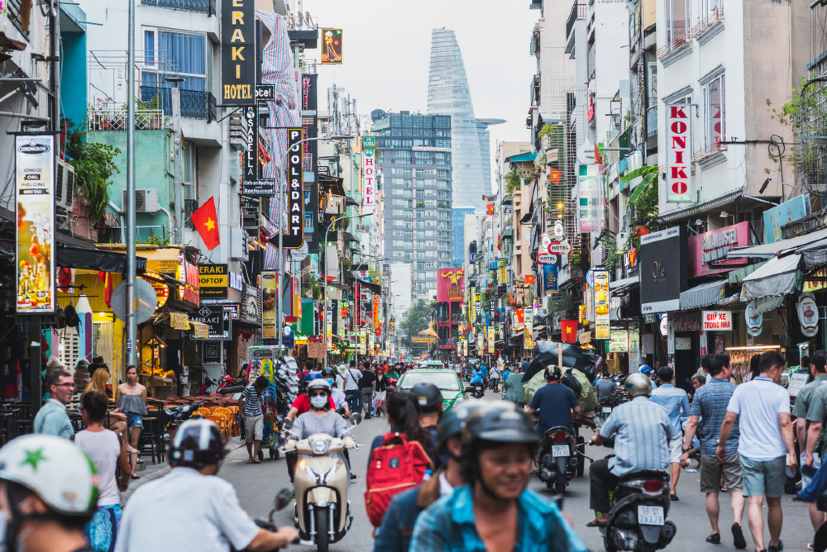
Vietnam's remarkable economic growth
Phoebe Goh
9 min read
According to the government’s website, which cited representatives from Saturday’s meetings, the minister also stated that economic growth could reach 7% this year as a result of advancements in the industrial and construction sectors. If the current growth momentum is sustained and accelerates, the growth rate in 2024 is expected to meet or even surpass the target set by the National Assembly.
The International Monetary Fund anticipates Vietnam’s GDP to rise by 6% this year, up from 5% in 2023. This growth rate would place Vietnam among the fastest-growing economies in Asia. In addition, the country is experiencing positive impacts from the surge in exports and foreign direct investment.
Vietnam’s pledged foreign direct investment (FDI) for the year is anticipated to reach between $39 billion and $40 billion, an increase from last year’s $36.6 billion as of December 2023. However, a significant challenge to the economy is the hesitance among government officials to allocate infrastructure funds, a consequence of the ongoing anti-corruption campaign that has stalled decision-making processes.
The allocation of public investment funds in the first half of the year has been lower compared to the same period last year, reaching only about 29.4% of Prime Minister Pham Minh Chinh’s target, down from approximately 30.5% in 2023. Prime Minister Chinh has consistently urged officials to expedite the spending of approved investment funds.
The ministry has outlined two potential economic growth scenarios for the remainder of the year. In the first scenario, GDP growth for the third and fourth quarters could be 6.5% and 6.6%, respectively. In the second scenario, the GDP growth for the third quarter could be as high as 7.4%, with the final quarter reaching 7.6%. In fact, Prime Minister Chinh has called on officials to strive for a third-quarter economic growth rate of between 6.5% and 7%. He also directed the central bank to maintain an adequate money supply and continue implementing policies to reduce lending interest rates and keep borrowing costs low to support businesses.
The economic growth of Vietnam has been ongoing at breakneck speed in the last few decades, with an average GDP growth rate of 7% annually in the past three decades, surpassing all its ASEAN regional peers. With domestic and external challenges ahead, Vietnam is expected to experience its slowest growth in 2023 and 2024, outside of the COVID years. However, this slowdown is likely to be temporary.
The road to becoming a middle-income country
When the 20-year Vietnam War ended in 1975, Vietnam’s economy was among the poorest in the world, with growth under the government’s subsequent five-year central plans being minimal. By the mid-1980s, per capita GDP was stagnating between $200 and $300. However, in 1986, a significant shift occurred when the government introduced “Đổi Mới,” a series of economic and political reforms that transitioned the country towards a “socialist-oriented market economy.”
Vietnam’s economic ascent can be attributed to three primary factors: first, an enthusiastic embrace of trade liberalisation; second, the complementing of external liberalisation with domestic reforms, including deregulation and lowering the cost of doing business; and third, substantial investments in human and physical capital, primarily through public investments.

In terms of trade liberalisation, analysts highlight the numerous free trade agreements Vietnam has entered into over the past two decades. In 1995, Vietnam joined the ASEAN free trade area. In 2000, it signed a free trade agreement with the US, and in 2007, it became a member of the World Trade Organisation. Since then, additional ASEAN agreements have been made with China, India, Japan, and Korea, with the amended Trans-Pacific Partnership taking effect this year, albeit without the US. These agreements collectively reduced tariffs on imports and exports to and from Vietnam.
The government’s push towards an open economy also involved domestic reforms. In 1986, Vietnam introduced its first law on foreign investments, allowing foreign companies to enter the country. This law has been updated multiple times to adopt a more investor-friendly approach, reduce administrative bureaucracy, and better facilitate foreign investment.
Consequently, Vietnam’s efforts have been recognised in international rankings. In the World Economic Forum’s Global Competitiveness Report, Vietnam climbed from 77th place in 2006 to 55th in 2017. In the World Bank’s Ease of Doing Business rankings, this Southeast Asian country improved from 104th place in 2007 to 68th place in 2017. Last year, it also made significant progress in areas such as enforcing contracts, increasing access to credit and electricity, paying taxes, and trading across borders.
Additionally, Vietnam invested heavily in human capital and infrastructure. With a rapidly growing population—now at 95 million, half of whom are under 35, up from 60 million in 1986—the country made substantial public investments in primary education to meet the growing need for jobs. The country also invested significantly in infrastructure, ensuring affordable mass access to the internet, which is crucial for the Fourth Industrial Revolution in Southeast Asia.
These investments have evidently paid off. Equipped with the necessary infrastructure and market-friendly policies, Vietnam has become a hub for foreign investment and manufacturing in Southeast Asia. Japanese and Korean electronics companies like Samsung, LG, Olympus, and Pioneer, along with numerous European and American apparel makers, have established operations in the country. By 2017, Vietnam was the largest exporter of clothing in the region and the second-largest exporter of electronics, after Singapore.
Economic growth followed. Since 2010, Vietnam’s GDP growth has consistently been at least 5% per year, peaking at 6.8% in 2017. This rapid growth transformed Vietnam from one of the poorest countries in the world to a comfortably middle-income nation. While its GDP per capita was just $230 in 1985, it exceeded $2,343 in 2017. Adjusted for purchasing power, it stands even higher, at over $6,000.
Importantly, the economic growth has been relatively inclusive. Vietnam is among a group of economies that have excelled in making their growth processes more inclusive and sustainable. Although some inequalities persist, women’s employment rates are within 10% of men’s, and women are less likely to lead poor households than men are.
Milestones to overcome
Could anything impede Vietnam’s progress? With the diminishing enthusiasm for globalisation in many regions, Vietnam appears particularly susceptible, as reported by the Financial Times earlier this year. Its exports constitute 99.2% of its GDP, and much of its success hinges on foreign investment and trade. Being an emerging market, it may also lose its appeal as an investment destination due to the strengthening dollar.
However, for now, Vietnam seems poised to benefit rather than suffer from escalating global trade tensions. Although the US has exited the Trans-Pacific Partnership, its antagonism has so far impacted China more than Vietnam. The US government has imposed tariffs on hundreds of billions of dollars’ worth of Chinese products, prompting companies with manufacturing sites in China to consider relocating to countries like Vietnam.

Even if Vietnam is affected by growing Western protectionism, it can still rely on its burgeoning middle class to drive the next phase of growth. Both domestic and international retailers are planning rapid expansion in the country, as more people gain the purchasing power to buy goods and services. This could imply that Vietnam might one day be known for its large malls and cars rather than the commotion of small shops and scooters. But how did this massive growth spike happen?
Vietnam’s growth spurt
Vietnam is forecast to see a 125% increase in wealth over the next decade, making it the largest expansion in wealth of any country in terms of GDP per capita and the number of millionaires. This astounding growth is being driven by a variety of factors.
Vietnam is becoming an increasingly popular manufacturing base for multinational tech, automotive, electronics, clothing, and textile firms due to its favourable business conditions. Even India, which is set to become the world’s third-largest economy by 2027, takes the second spot with an expected 110% growth in wealth over the same period. This indicates the exceptional economic trajectory Vietnam is on.
With 19,400 millionaires and 58 centimillionaires, Vietnam is perceived as a relatively safe country compared with other nations in the Asia-Pacific region. This perception provides companies with an extra incentive to set up manufacturing operations there, further fueling economic growth.
The country’s strategic location, sharing a land border with China and being close to major maritime trade routes, combined with low labour costs and infrastructure supporting exports, has all transformed Vietnam into a prime destination for international investments. However, it is important to note that Vietnam’s 2023 GDP growth slowed to 5.05% compared with an 8.02% expansion in 2022 due to dimmer global demand and stalled public investment. Despite this, manufacturing still accounts for a significant portion, roughly a quarter, of its GDP.
Looking back just 10 years, Vietnam’s GDP per capita was around $2,190. This figure has nearly doubled to $4,100 today, showcasing rapid development that is benefiting most of the population. This economic progress is not just in numbers; it translates to real improvements in living standards for Vietnamese citizens.
Additionally, the country is benefiting from ongoing US-China trade tensions. Many multinational companies are adopting a “China plus one” strategy, diversifying their manufacturing bases to include Vietnam. This trend has contributed to consistently strong foreign direct investment (FDI) from multinational corporations. In fact, FDI into Vietnam rose 32% from a year earlier to $36.6 billion in 2023.
These foreign investments are often referred to as “sticky money,” because they result in good jobs that pay decent wages, enabling millions of Vietnamese people to improve their quality of life. The investments are long-term and deeply integrated into the local economy, making them resilient to short-term economic fluctuations.
Vietnam’s growth story has been propelled by export-led industrialisation, driven by three waves of FDI over the past three decades. Now, the country is on the verge of a fourth wave. This upcoming wave is expected to further consolidate Vietnam’s position as a manufacturing hub and continue to drive economic growth, ensuring that the nation remains on its upward trajectory.
A Trader’s View
Previously, we talked about using the US inflation rate as an indicator to forecast the movement of USD, and currently, the inflation rate is still fluctuating near the mean, as shown in the chart below.

USD has been trading sideways for the last 3 months and is expected to continue to trade sideways, as shown in the chart below.

Although USD is expected to be trading sideways, there are always opportunities in the market for traders to trade on. One of the currency pairs I am currently looking at is GBPUSD, as the UK inflation rate continues to trend lower and below its 10-year mean, as shown below.


And using basic indicators such as the Fibonanci ratio, we are able to identify that GBPUSD is unable to break above the 0.618 and 0.782 ratios in the short term. I personally will be expecting downward pressure on GBPUSD and looking to short GBPUSD in the short term.
Terry Loh

















